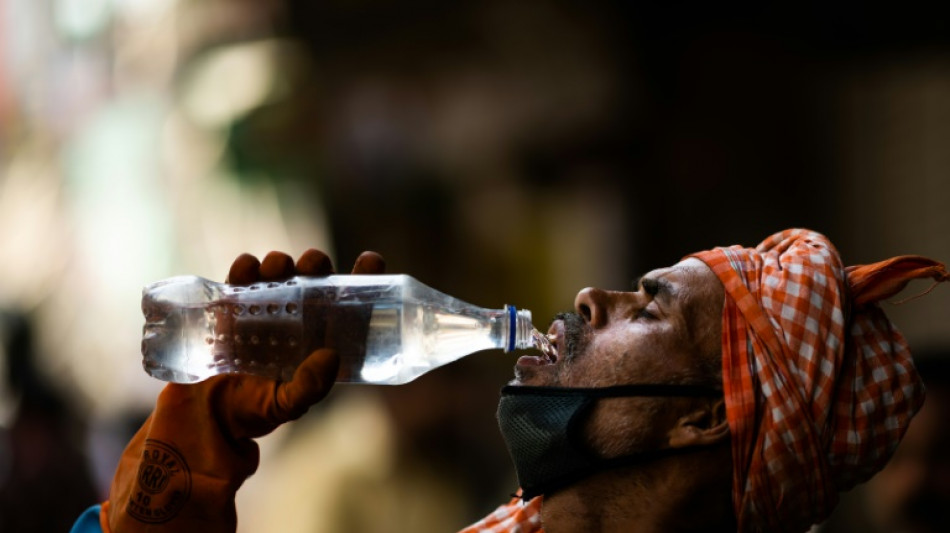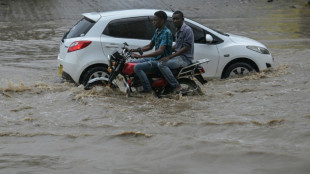
-
 Kenya's economy faces climate change risks: World Bank
Kenya's economy faces climate change risks: World Bank
-
Campaigning starts in Central African Republic quadruple election

-
 'Stop the slaughter': French farmers block roads over cow disease cull
'Stop the slaughter': French farmers block roads over cow disease cull
-
First urban cable car unveiled outside Paris

-
 Why SpaceX IPO plan is generating so much buzz
Why SpaceX IPO plan is generating so much buzz
-
US unseals warrant for tanker seized off Venezuelan coast

-
 World stocks mostly slide, consolidating Fed-fuelled gains
World stocks mostly slide, consolidating Fed-fuelled gains
-
Crypto firm Tether bids for Juventus, is quickly rebuffed

-
 UK's king shares 'good news' that cancer treatment will be reduced in 2026
UK's king shares 'good news' that cancer treatment will be reduced in 2026
-
Can Venezuela survive US targeting its oil tankers?

-
 Salah admired from afar in his Egypt home village as club tensions swirl
Salah admired from afar in his Egypt home village as club tensions swirl
-
World stocks retrench, consolidating Fed-fuelled gains

-
 Iran frees child bride sentenced to death over husband's killing: activists
Iran frees child bride sentenced to death over husband's killing: activists
-
World stocks consolidate Fed-fuelled gains

-
 France updates net-zero plan, with fossil fuel phaseout
France updates net-zero plan, with fossil fuel phaseout
-
Stocks rally in wake of Fed rate cut

-
 EU agrees recycled plastic targets for cars
EU agrees recycled plastic targets for cars
-
British porn star to be deported from Bali after small fine

-
 British porn star fined, faces imminent Bali deportation
British porn star fined, faces imminent Bali deportation
-
Spain opens doors to descendants of Franco-era exiles

-
 Indonesia floods were 'extinction level' for rare orangutans
Indonesia floods were 'extinction level' for rare orangutans
-
Thai teacher finds 'peace amidst chaos' painting bunker murals

-
 Japan bear victim's watch shows last movements
Japan bear victim's watch shows last movements
-
South Korea exam chief quits over complaints of too-hard tests

-
 French indie 'Clair Obscur' dominates Game Awards
French indie 'Clair Obscur' dominates Game Awards
-
South Korea exam chief resigns after tests dubbed too hard

-
 Asian markets track Wall St record after Fed cut
Asian markets track Wall St record after Fed cut
-
Laughing about science more important than ever: Ig Nobel founder

-
 Vaccines do not cause autism: WHO
Vaccines do not cause autism: WHO
-
Crypto mogul Do Kwon sentenced to 15 years for fraud: US media

-
 'In her prime': Rare blooming of palm trees in Rio
'In her prime': Rare blooming of palm trees in Rio
-
Make your own Mickey Mouse clip - Disney embraces AI

-
 OpenAI beefs up GPT models in AI race with Google
OpenAI beefs up GPT models in AI race with Google
-
Dark, wet, choppy: Machado's secret sea escape from Venezuela

-
 Cyclone causes blackout, flight chaos in Brazil's Sao Paulo
Cyclone causes blackout, flight chaos in Brazil's Sao Paulo
-
2024 Eurovision winner Nemo returns trophy over Israel's participation

-
 US bringing seized tanker to port, as Venezuela war threats build
US bringing seized tanker to port, as Venezuela war threats build
-
Make your own AI Mickey Mouse - Disney embraces new tech

-
 Time magazine names 'Architects of AI' as Person of the Year
Time magazine names 'Architects of AI' as Person of the Year
-
Floodworks on Athens 'oasis' a tough sell among locals

-
 OpenAI, Disney to let fans create AI videos in landmark deal
OpenAI, Disney to let fans create AI videos in landmark deal
-
German growth forecasts slashed, Merz under pressure

-
 Thyssenkrupp pauses steel production at two sites citing Asian pressure
Thyssenkrupp pauses steel production at two sites citing Asian pressure
-
ECB proposes simplifying rules for banks

-
 Stocks mixed as US rate cut offset by Fed outlook, Oracle earnings
Stocks mixed as US rate cut offset by Fed outlook, Oracle earnings
-
Desert dunes beckon for Afghanistan's 4x4 fans

-
 Breakout star: teenage B-girl on mission to show China is cool
Breakout star: teenage B-girl on mission to show China is cool
-
Chocolate prices high before Christmas despite cocoa fall

-
 Austria set to vote on headscarf ban in schools
Austria set to vote on headscarf ban in schools
-
Asian traders cheer US rate cut but gains tempered by outlook


'Dangerous' heatwaves likely to grip the tropics daily by 2100: study
Many millions of people in the tropics could be exposed to dangerous heat for half the year by 2100 even if humanity manages to meet climate goals, researchers warned Thursday.
In the most likely scenario, the world would miss those targets -- potentially subjecting people across the tropics to harmful temperatures most days of each typical year by the end of the century, the study found.
If emissions go unchecked, large numbers of people in these regions could face potentially "nightmarish" periods of extreme heat.
"There's a possibility that if we don't get our act together, billions of people are going to be really, really overexposed to these extremely dangerous temperatures in a way that we just fundamentally haven't seen," said lead author Lucas Vargas Zeppetello of Harvard University.
Severe heatwaves -- made hotter and more frequent by climate change -- are already being felt across the world, threatening human health, wildlife and crop yields.
Most climate projections predict temperature increases under different policy scenarios, but do not say which of those pathways is more likely.
In this study, published in the journal Communications Earth and Environment, researchers estimated potential exposure to dangerous heat and humidity.
They used statistical projections to predict levels of carbon dioxide emissions from human activity and the resultant levels of global warming.
They found that many people in tropical regions could face dangerous heat levels for half the year by the end of the century, even if the world limits temperature rises to the Paris climate deal goal of less than two degrees Celsius (35.6 degrees Fahrenheit) above preindustrial levels.
Outside the tropics, they said deadly heatwaves will likely become annual occurrences.
The researchers used a heat index that puts "dangerous" levels at 39.4C, while temperatures above 51C are considered "extremely dangerous" and totally unsafe for humans.
The extreme measure was originally developed for people working in scorching indoor environments, like a ship's boiler room, and have rarely been observed outdoors, Zeppetello said.
But by the end of the century, the researcher said it was "virtually guaranteed" that people in some parts of the tropics would experience this level of heat every year unless emissions are severely curtailed, with swathes of sub-Saharan Africa and India particularly at risk.
"That's pretty scary," he told AFP, adding that even walking outside would be dangerous under those conditions.
- 'Nightmarish' conditions -
Earth has warmed nearly 1.2C so far and current predictions based on countries' carbon-cutting pledges would see the world far exceed the Paris Agreement's 2C target for 2100, let alone its more ambitious 1.5C aspiration.
In their research Zeppetello and colleagues analysed predictions from global climate models, human population projections, and looked at the relationship between economic growth and carbon emissions.
They estimated that there is only a 0.1 percent chance of limiting global average warming to 1.5C by 2100, projecting that the world is likely to reach 1.8C by 2050.
In 2100, the researchers found, the most likely global average temperature rise would be 3C, which Zeppetello said would spell "nightmarish" conditions for many people.
In a worst case scenario, in which emissions continue unchecked, he said extreme temperatures could last up to two months every year in parts of the tropics.
But he said it depends on how swiftly humanity can cut emissions.
"We don't have to go to that world. There's nothing right now that says it is a certainty, but people need to be aware of just how dangerous that would be if it were to pass," he said.
The researchers said that under all scenarios there could be a large increase in heat-related illnesses, particularly among the elderly, vulnerable and those working outside.
"I think this is a very important point that is receiving far too little attention," said Kristin Aunan, a research professor at the Center for International Climate Research specialising in emissions and human health, who was not involved in the study.
"Reduced workability in outdoor environments could have large economic impacts in addition to the human suffering arising from having to work under extreme temperatures," she told AFP, adding crop production and livestock can also be affected by temperature extremes.
Y.Ponomarenko--CPN
